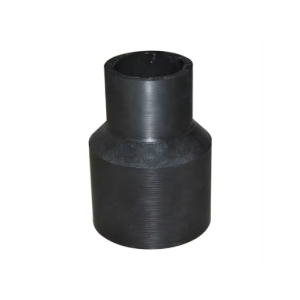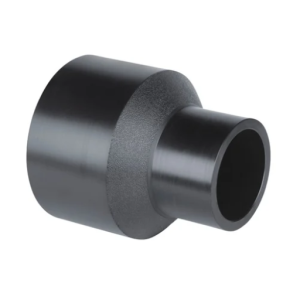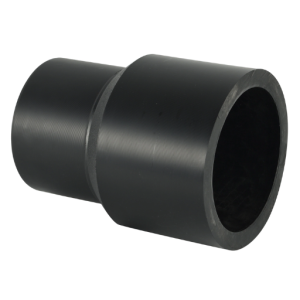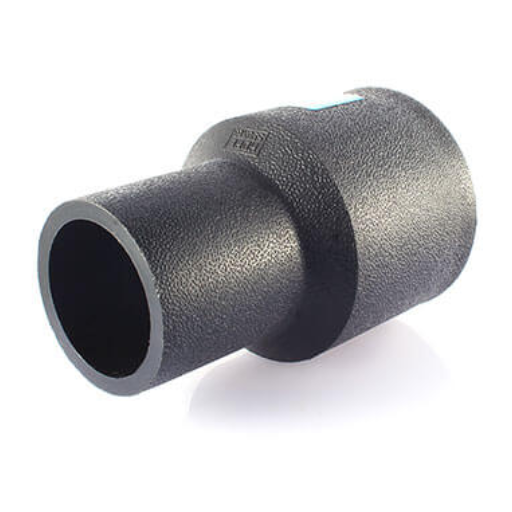HDPE is an acronym for high-density polyethylene, known for its strong and rigid nature and various piping applications. HDPE piping systems have butt fusion reducer couplers that are valuable components, among others, which can help to connect different sizes of pipes securely. This paper seeks to highlight the features and processes involved in installing HDPE butt fusion reducer couplers as well as their advantages. Plumbers, engineers, or even amateurs who want to increase their knowledge about these products will find this article useful.
What is Butt Fusion and How Does it Work?

Image source: https://www.alibaba.com/
Butt fusion refers to a technique that uses heat to join two pieces of HDPE pipe or fittings by melting their outer surfaces and pushing them together until they bond. Many steps are followed during the process: firstly, trimming and aligning the ends of the pipes so that they come together correctly. It is heated using a heating element to bring polyethylene up to proper heat temperature. When this happens, the heating element is removed while softening ends are forced against each other under regulated pressure until the predetermined cooling time elapses. It creates joints whose strength equals or surpasses a pipe itself; this makes it suitable for critical applications in water and gas distribution networks.
Definition and Basic Principles of Butt Fusion
Butt Fusion is a kind of method for joining polyethylene (PE) pipes and fittings, which refers to a thermoplastic welding process. This technique ensures that controlled heat and pressure make a continuous homogeneous joint possible. The basic principles involve trimming and aligning the pipe ends, heating them till soft, then pressing them together. This process ensures that the fused joint is as resilient and leak-proof as the pipe, making it suitable for high-demand applications such as water pipelines, natural gas distribution, and other critical utility infrastructures. To achieve success with butt fusion, precise temperature control on top of proper alignment of the pipe ends must be done since these factors ultimately determine how strong or intact the connection will turn out.
Advantages of Using Butt Fusion for HDPE Pipes
The advantages of using butt fusion on HDPE pipes are numerous hence its wide application in various areas. Firstly, this process results in joints that tend to have equal or greater strength than the pipes themselves; thus, they can withstand high pressures guaranteed without breaking down. Secondly, the absence of additional materials like adhesives or fillers reduces the chances of potential weaknesses and damages over a long period. Other than this reason, butt fusion allows for seamless flow inside the pipeline, causing minimum turbulence hence leading to efficiency. In addition to saving on time during installation because skilled personnel s are not required since it only involves quick, even joining at lower price rates, it also simplifies installation, reducing labor expenses. Ultimately, when considering HDPE piping systems in water or gas distribution networks, reliability combined with efficiency and robustness makes butt fusion a preferred choice.
Common Applications of Butt Fusion in Various Industries
Due to its efficiency and the strength of joints created, butt fusion is widely used in many industries. In municipal and industrial water systems, for instance, it is commonly employed for linking HDPE pipes, thus ensuring that no leakage will occur, especially under high pressure. The oil and gas sector also uses butt fusion in natural gas pipeline construction as it provides a challenging alternative that can cope with harsh environmental conditions. On top of this, in the agriculture industry, butt fusion is applied to irrigation systems because it enhances water flow on top of preventing leakages that are common with traditional jointing methods. These examples prove how adaptable butt fusion is to different application areas where infrastructure durability is paramount.
Understanding the HDPE Butt Fusion Reducer: Key Benefits

The HDPE butt fusion reducer has some advantages that make it valuable in pipe systems. One advantage is that it offers a smooth transition between different sizes of pipes, thereby enabling fluids to flow without any turbulence, which allows the system to operate at an optimal pace. Additionally, the process creates solid and homogeneous joints without weak points, reducing risks related to leaks and making them last longer. Moreover, using a reducer pipe reduces installation complexity by minimizing the number of fittings, leading to reduced labor costs and time used in installation procedures. In summary, therefore, HDPE butt fusion reducers are critical elements in achieving robust as well as efficient piping networks across various applications.
Benefits of Using HDPE in Butt Fusion Reducers
Butt fusion reducers produced using HDPE have a lot of advantages, which has increased their popularity in different sectors. First and foremost, HDPE is appreciated for its excellent chemical resistance; thus, it can transport various fluids without contamination or degradation. Secondly, being lightweight and easy to handle, HDPE simplifies the installation process, reducing labor costs and time spent. In addition, HDPE possesses high tensile strength and is flexible, meaning it can withstand environmental stresses and physical impacts. The material’s corrosion resistance and long lifespan help improve the efficiency of piping systems. Lastly, HDPE butt-fusion reducers have numerous ecological benefits, such as recyclability and reduced carbon footprint during production processes, making them suitable choices for sustainable infrastructure development.
Comparing HDPE Butt Fusion Reducers with Other Fittings
In considering the performance of HDPE butt fusion reducers against PVC pipe fittings and metal reducers, among others, it is worth noting that continuously these products perform better in many important areas. For example, unlike PVC, which becomes brittle over time, this plastic remains flexible at extreme temperatures, ensuring that pipes serving households last longer. Furthermore, while metals tend to rust more efficiently, leading to higher maintenance costs, chemical resistance in this type of PE helps reduce long-term expenses.
The process involved in installing an HDPE butt fusion reducer is generally easier than fitting a metal reducer which usually requires specialized tools and skills like welding. The continuous flow path created by seamless jointing via butt fusion leads to minimized risks of mechanical leakages compared to other materials with their common bolt joints. Consequently, the combination of these features implies that HDPE butt fusion remains unmatched, especially when looking for a reliable, affordable solution, plus a durable one for many industrial applications.
Long Service Life and Durability of HDPE Butt Fusion Reducers
HDPE has created HDPE butt fusion reducers, but fusion reducers are made to be immensely durable and have a long life, making them suitable for various pipe applications. One of the reasons they last longer is a result of HDPE’s inherent environmental stress cracking resistance; it is not affected by UV radiation, chemicals, and temperature variations. According to those who know about this matter, HDPE can withstand severe operating conditions without significant deterioration in performance over time.
In addition, the seamless connections formed during butt fusion guarantee the structural integrity of these fittings, reducing the likelihood of leaks failure or joint separation. Many manufacturers offer extensive guarantees, often for more than 50 years, demonstrating their confidence in HDPE goods’ dependability over long periods. These factors taken together mean that HDPE butt fusion reducers will continue to be a reliable choice in the future due to their combination of solid materials, innovative production methods, and protective traits.
How to Install an HDPE Butt Fusion Reducer Coupler

To ensure a safe and tight connection when putting in an HDPE butt fusion reducer coupler, there are several steps to be followed. Primarily, it is necessary to clean the surface of pipes and coupling by thoroughly removing any dirt, moisture, or other debris. Next, place the pipes and coupler in the proper position where they fit correctly.
When set correctly, utilize a fusion machine to simultaneously heat the ends of the coupler and pipes until each attains appropriate temperatures, about 200°C (392°F). Once temperature has been attained, quickly pressurize the hot ends for a certain duration so that materials can join.
Finally, let the joint calm and undisturbed according to the manufacturer’s guidelines before conducting a pressure test on the system to ascertain its integrity. By following these stages, one will develop a good and reliable joint that suits different applications.
Step-by-Step Installation Guide for HDPE Butt Fusion Reducers
- Materials preparation: Have all needed tools, including a fusion machine, pipe cutters, scraper, and tape measure, ready. Have HDPE pipes and reducers available for installation.
- Pipe cleaning: Properly clean the ends of pipes and the butt fusion reducer to remove any soil, grease, or contaminants. This is very important to get a good quality fusion.
- Pipe alignment: Arrange the pipes and reducer in place correctly, making sure they fit tightly and are in perfect alignment. They should have straight, even edges, establishing proper contact between them.
- Heating process: set temperature on the fusion machine (about 200°C or 392°F). It takes heating both pipe and reducer ends simultaneously until they melt evenly.
- Joint fusing: As soon as each material has reached its melting point, it should be brought together under controlled pressure, allowing its heated surfaces to bond together. Maintain constant pressure during the recommended period for fusing.
- Cooling time: A minimum of undisturbed joint relaxation must be allowed, after which it will cool completely. Depending on the manufacturer’s specifications, this cooling time can vary but is essential for achieving a solid bond.
- Joint testing: When it cools down, examine it by increasing its pressure so that you can check if there are leaks. Comply with any specific test concerning what makers of such items advise on.
By following these steps, one can achieve a successful HDPE butt fusion reducers installation that creates strong connections which last long in various applications.
Necessary Tools and Preparation for Installation
Essential tools and preparations before starting the installation of HDPE butt fusion reducers:
- Tools Required:
- Fusion Machine: A primary instrument for heating and combining HDPE materials.
- Pipe Cutters: To cut pipes accurately to the correct lengths.
- Scraper: It cleans and prepares the ends of the pipe and fusion surfaces.
- Measuring Tape: This tool is for precise measurement to achieve proper alignment.
- Materials:
- HDPE Pipes: Ensure you have the right size and lengths of HDPE pipes.
- Reducers: Make sure you have enough HDPE reducers for installation.
- Preparation Steps:
- Safety Gear: To shield yourself from harm, wear suitable safety equipment, such as gloves and goggles, when performing fusions.
- Work Area: Always keep your working area clean so that it is free from dirt that can cause contamination to your fusion surfaces
- Review Manufacturer’s Guidelines: Go through the manufacturer’s instructions on temperature settings and duration of fusing, among others
A smooth, successful process can be ensured by having appropriate tools and getting ready for your work area.
Common Mistakes to Avoid During Installation
There are three most critical mistakes to avoid when you install HDPE butt fusion reducers. The first thing is to know the surface preparation of these connections to improve quality and make them last longer.
- Inadequate Surface Preparation: If you fail to clean the ends of your pipes and surfaces where fusion will take place properly, poor fusion can occur. Therefore, it is important to use a scraper to get rid of dust, dirt, or moisture before beginning the process of fusion.
- Incorrect Temperature Settings: Failure to adhere to the manufacturer’s temperature recommendations may cause materials to underheat or overheat. Ensure that the fusion machine is calibrated correctly and that the temperature is monitored during this process.
- Improper Alignment of Pipes: Pipe misalignment during fusion can create stress points and leaks in connections over time. So, take time to measure and accurately align all the pipes before initiating any kind of fusion process so that everything fits together tightly and smoothly.
By avoiding such common mistakes, you can increase your effectiveness during installation, thus improving the longevity of the HDPE system’s reliability.
Reference sources
-
HDPE Butt Fusion Reducer Coupler – HDPE Supply
This source provides detailed information on various sizes and specifications of molded butt fusion reducer couplers, suitable for multiple applications. It offers insights into these fittings’ use cases and technical details, making it an essential resource for professionals and engineers.
Read more -
HDPE Butt Fusion Reducer Coupler – SUNPLAST
This page offers comprehensive information on HDPE butt fusion reducer couplers used to join HDPE pipes of different diameters, available in various sizes and pressure ratings. The site also discusses the manufacturing process and quality standards.
Read more -
HDPE Butt Fusion Reducer Coupler – ISCO
ISCO’s page covers the specifics of HDPE butt fusion reducer couplers, including their production standards, testing procedures, and quality assurance measures. The content also delves into the benefits and applications of these fittings in various industries, such as water supply and industrial systems.
Read more
Related Articles: Butt Fusion Reducer Coupler Performance Introduction






